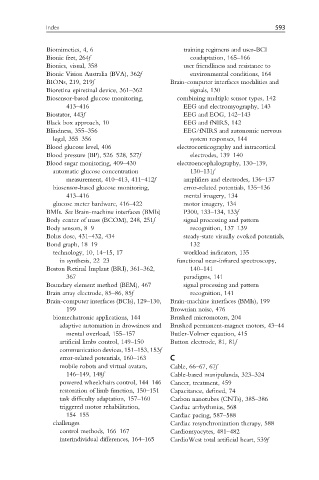Page 601 - Handbook of Biomechatronics
P. 601
Index 593
Biomimetics, 4, 6 training regimens and user-BCI
Bionic feet, 264f coadaptation, 165–166
Bionics, visual, 358 user friendliness and resistance to
Bionic Vision Australia (BVA), 362f environmental conditions, 164
BIONs, 219, 219f Brain-computer interfaces modalities and
Bioretina epiretinal device, 361–362 signals, 130
Biosensor-based glucose monitoring, combining multiple sensor types, 142
413–416 EEG and electromyography, 143
Biostator, 443f EEG and EOG, 142–143
Black box approach, 10 EEG and fNIRS, 142
Blindness, 355–356 EEG/fNIRS and autonomic nervous
legal, 355–356 system responses, 144
Blood glucose level, 406 electrocorticography and intracortical
Blood pressure (BP), 526–528, 527f electrodes, 139–140
Blood sugar monitoring, 409–430 electroencephalography, 130–139,
automatic glucose concentration 130–131f
measurement, 410–413, 411–412f amplifiers and electrodes, 136–137
biosensor-based glucose monitoring, error-related potentials, 135–136
413–416 mental imagery, 134
glucose meter hardware, 416–422 motor imagery, 134
BMIs. See Brain-machine interfaces (BMIs) P300, 133–134, 133f
Body center of mass (BCOM), 248, 251f signal processing and pattern
Body sensors, 8–9 recognition, 137–139
Bolus dose, 431–432, 434 steady-state visually evoked potentials,
Bond graph, 18–19 132
technology, 10, 14–15, 17 workload indicators, 135
in synthesis, 22–23 functional near-infrared spectroscopy,
Boston Retinal Implant (BRI), 361–362, 140–141
367 paradigms, 141
Boundary element method (BEM), 467 signal processing and pattern
Brain array electrode, 85–86, 85f recognition, 141
Brain-computer interfaces (BCIs), 129–130, Brain-machine interfaces (BMIs), 199
199 Brownian noise, 476
biomechatronic applications, 144 Brushed micromotors, 204
adaptive automation in drowsiness and Brushed permanent-magnet motors, 43–44
mental overload, 155–157 Butler-Volmer equation, 415
artificial limbs control, 149–150 Button electrode, 81, 81f
communication devices, 151–153, 153f
error-related potentials, 160–163 C
mobile robots and virtual avatars, Cable, 66–67, 67f
146–149, 148f Cable-based manipulanda, 323–324
powered wheelchairs control, 144–146 Cancer, treatment, 459
restoration of limb function, 150–151 Capacitance, defined, 74
task difficulty adaptation, 157–160 Carbon nanotubes (CNTs), 385–386
triggered motor rehabilitation, Cardiac arrhythmias, 568
154–155 Cardiac pacing, 587–588
challenges Cardiac resynchronization therapy, 588
control methods, 166–167 Cardiomyocytes, 481–482
interindividual differences, 164–165 CardioWest total artificial heart, 539f

